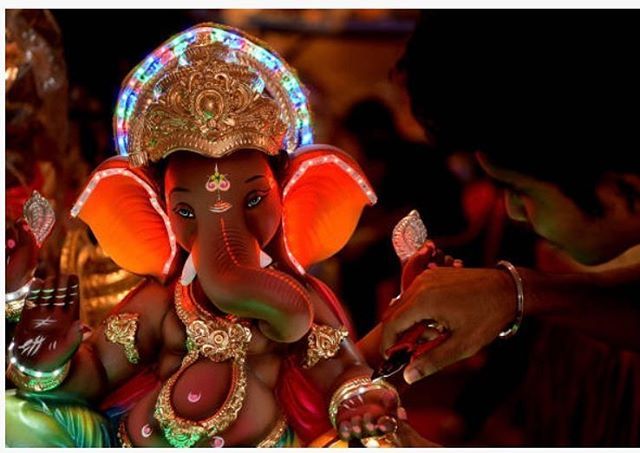As September nears, so many of us start thinking about the same thing. That Ganpati Bappa will be home and the amount of sweets we will be able to eat because he is home.
Ganpati festival has been a part of our cultures for years and years. Ganesh Chaturthi, also known as Vinayaka Chaturthi, is a Hindu festival that commemorates Ganesh’s entrance on Earth from Kailash Parvat with his mother Goddess Parvati/Gauri. Shri Bal Gangadhar Tilak, commonly known as Lokmanya Tilak, installed Ganesh clay murtis individually in houses and publicly on ornate pandals in Pune in the year 1893. (temporary stages). Chanting of Vedic hymns and Hindu literature such as prayers and vrata are among the observations (fasting). Offerings and prasda from daily prayers are given from the pandal to the community, and include delicacies such as modaka, which is thought to be a favourite of Lord Ganesh. On the tenth day after the celebration begins, the idol is taken in a public parade with music and group chanting, then immersed in a nearby body of water such as a river or sea. Every year, about 150,000 sculptures are submerged in Mumbai alone. Following that, the clay idol is said to crumble, and Ganesh is said to return to Mount Kailash to be with Parvati and Shiva.
Mentions in scriptures of the deity
Though not referring to the traditional form of Ganapati, the Rigveda has the first reference of Ganapati. It is mentioned twice in the Rigveda, once in shloka 2.23.1 and once in shloka 10.112.9. According to Michael, both of these shlokas suggest a position for Ganapati as “the seer among the seers, overflowing beyond measure in food, reigning among the elders, and being the lord of an invocation,” but the shloka in mandala 10 declares that “nothing close or distant is done without thee.” However, it is unclear if the Vedic name Ganapati, which literally means “protector of the multitudes,” pertained particularly to later-era Ganesh, and the Vedic writings make no mention of Ganesh Chaturthi. Ganapati is mentioned in post-Vedic literature such as the Grhya Sutras, and then in ancient Sanskrit texts such as the Vajasaneyi Samhita, the Yajnavalkya Smriti, and the Mahabharata as Ganesvaras and Vinayak. Ganesh appears in the mediaeval Puranas as the “god of prosperity, remover of obstacles.” The Skanda Purana, Narada Purana, and Brahma Vaivarta Purana all lavishly laud him. Aside from literary interpretations, archaeological and epigraphic evidence indicate that Ganesh was popular and worshipped before the 8th century CE, with various representations of him dating back to the 7th century or before. Carvings in Hindu, Buddhist, and Jain temples, such as those at the Ellora Caves, dating between the fifth and eighth centuries, show Ganesh reverently sitting with important Hindu goddesses (Shakti).
Emergence of the festival
Although it is uncertain when (or how) Ganesh Chaturthi was originally observed, the holiday has been celebrated publicly in Pune since the reign of Shivaji (1630–1680, founder of the Maratha Empire). The Peshwa kings of the 18th century were Ganesh worshippers who established a public Ganesh celebration in Pune, their capital city, during the month of Bhadrapad. After the British Raj began, the Ganesh festival lost governmental support and became a private family celebration in Maharashtra until it was revived by Indian independence warrior and social reformer Lokmanya Tilak.
Others, including Kaur, believe that the celebration became a public event later, in 1892, when Bhausaheb Laxman Javale (also known as Bhau Rangari) erected Pune’s first sarvajanik (public) Ganesh idol. Lokmanya Tilak, an Indian independence warrior, lauded the Sarvajanik Ganesh Utsav celebration in his newspaper, Kesari, in 1893, and committed his efforts to turning the yearly household festival into a huge, well-organized public event. Tilak saw Ganesh’s appeal as “the god for everyone,” and according to Robert Brown, he picked Ganesh as the deity who bridged “the divide between Brahmins and non-Brahmins,” therefore fostering grassroots unity against British colonial power.
Ganesh Chaturthi predates the Kadamba era in Goa. The Goa Inquisition prohibited Hindu festivities and severely restricted Hindus who did not convert to Christianity. Despite the limitations, Hindu Goans continued to follow their faith. Many households worship Ganesh using patri (leaves used to worship Ganesh or other gods), a drawing on paper, or tiny silver statues. Due to a prohibition on clay Ganesh idols and celebrations imposed by the Jesuits as part of the Inquisition, Ganesh idols are concealed in certain houses, a characteristic peculiar to Ganesh Chaturthi in Goa.
The presence of Chaturthi Thithi generally determines the date of the event. The event takes place during the “Bhadrapada Madyahanaa Purvabaddha.” If the Chaturthi Thiti begins at night the previous day and ends by dawn the next day, the next day is known as Vinayaka Chaturthi. A priest conducts a Prana Pratishtha during the consecration ritual to invite Ganesh as a guest. The 16-step Shodashopachara ceremony (Sanskrit: Shodash, 16; Upachara, process) follows, during which coconut, jaggery, modaks, durva grass, and red hibiscus (Jaswand) flowers are presented to the deity.
In the Gregorian calendar, Ganesh Chaturthi falls between 22 August and 20 September every year. The festival honours Lord Ganesh as the God of New Beginnings and Obstacle Removal, as well as the god of wisdom and intelligence, and is celebrated throughout India, particularly in Maharashtra, Karnataka, Rajasthan, Madhya Pradesh, Andhra Pradesh, Telangana, Odisha, Goa, West Bengal, Gujarat, Chhattisgarh, and Tamil Nadu. Ganesh Chaturthi is also celebrated by the Hindu diaspora in Australia, New Zealand, Canada, Singapore, Malaysia, Trinidad & Tobago, Guyana, Suriname, other areas of the Caribbean, Fiji, Mauritius, South Africa, the United States, and Europe.
Festivals bring families and loved ones closer together. Let’s celebrate the immense love and adoration we have for Ganpati Bappa!


